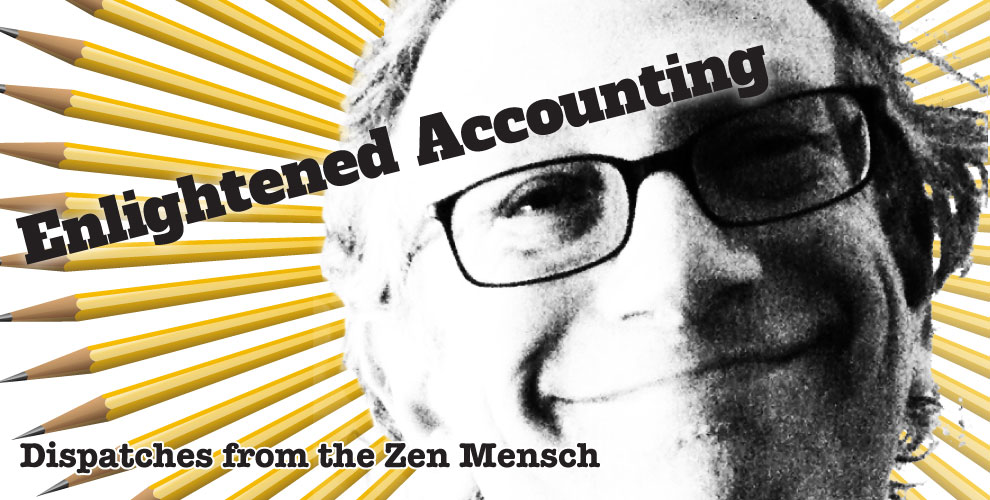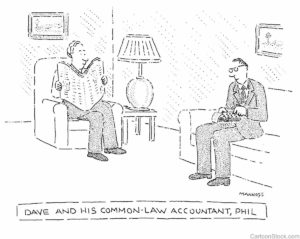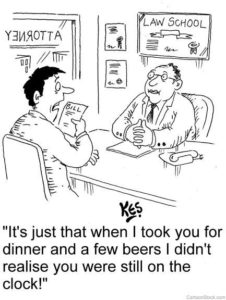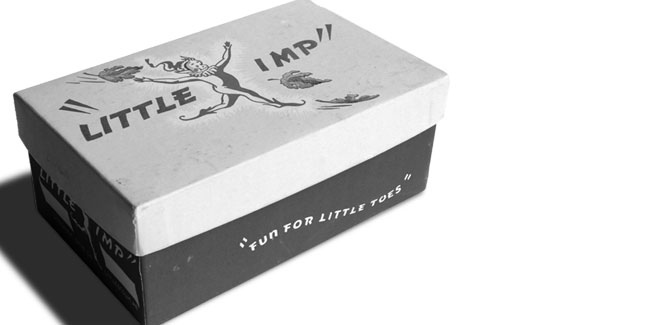Peace, Love and Financial Planning
The following is an excerpt from “Peace, Love and Financial Planning — An Illustrated Guide to Money”, by E. Larson Gunness, a local financial planner (and friend).
Note: “You” is the narrator in the book, who is working for a local accounting firm.
Art Comes in for a Meeting
One day, a person named Art comes in, looking for help. You know Art, have known him for a while.
Rich calls you to sit in on the meeting and take notes. You’re a bit bashful when you step into the conference room and are introduced to someone you know from the outside world.
But Art doesn’t seem to recognize you. He just sits down facing Rich. But, you tell yourself, Art’s Art and he can be a bit goofy at times.
You watch him. He seems uncomfortable. In fact he seems downright rattled. As you take out a clean sheet of paper, you reflect that it’s been a couple of years since you’ve seen him. Last you heard, he was still the prodigious prodigy, cranking out quality piece after quality piece. After so many years selling all those high priced paintings, he must have quite a bit of money by now.
Rich begins the conversation with small talk, apparently trying to get Art to relax. But Art will have none of it. Art never did go in for nice-nice.
Art Explains
“I DON’T WANT TO GO TO PRISON,” Art blurts out, to which Rich visibly flinches.
“Uhm, say more,” Rich says
Art leans back in his chair and looks around the room, examining everything except for Rich. At that moment, Art appears like nothing so much as a stray dog, cornered and frightened. For a moment, you’re not sure what’s going to happen next. Anything seems possible.
Then Art closes his eyes and goes quiet for a moment. When he opens them again, he’s regained his composure. He draws a breath and launches into his story. He speaks spasmodically and fast. You struggle to keep up with your notes. Rich just sits back and listens, occasionally picking up his pen to jot down a brief note.
“I don’t want to go to prison,” Art says again. Only this time, he says it in a calm, even tone, firm with resolution.
“I’ve always done well with my painting. It’s the only thing I ever do, only thing I’ve ever done. I can’t say that I do a good job or bad, because it’s all I do. I paint.
And people have always seemed to want my paintings, which used to amuse me. I mean I paint all the time anyway, so if someone wants to go through and buy from the piles of canvas I have in my shed, then so be it.
But I don’t see it that way now. Wasn’t too long after I got out of art school that I realized I need to eat. And I’m not trained to do any other kind of work.
“So I met this woman At one of my local shows. Her name’s Katya and she owns a big swanky gallery in Manhattan. Well, long story short, she got all excited about my work and said she wanted to help me sell my art through her gallery.”
Art Meets Katya
“So for the past two years, it’s been pretty simple: every couple of months or so, I send a few paintings to her. Well, at first I just threw them in the back of my car and drove them down to her, but when I asked her to help me unload one time in the rain, she got all freaked out and since then she’s insisted that I take them to the UPS store to have them packed and shipped. I keep telling her it’s an expensive way to ship, but she says she can afford it, so I let her have her way.
Anyway, for a while we went on like that. I’d send her the paintings. A few days later I’d get a check in the mail. I’d cash the checks, spend some of the money, put the rest in my stash, and send her more paintings. It was all good.
Then last October, she decided to stop selling my paintings for a little while. She said she wanted to let anticipation build, that people were coming in looking for my work and she wanted to play hard to get or something in order to do a big show around my work in a year or so.
Katya said she felt bad that she had to disrupt my cash flow. I didn’t tell her that it didn’t matter to me, that I never spent a lot of the money I got from her checks anyway.
So she gave me a job down at her gallery. I go down there every other week. I do whatever needs to be done, like hanging pictures, sweeping up, painting walls, or whatever. Then at night I crash at her brother’s place, which is fine because he’s I guess living in Europe so I get his loft all to myself. Then after the week’s up, I drive up to my studio again and sleep and paint some more.
I was feeling pretty good about things. I have this super cush job. I get to live in this apartment in the middle of New York. There’ll be a big showing of my work some time soon.
I remember thinking: “What could go wrong?”
Art Receives a W-9
“Well, basically the same day I asked myself that question, I came back to my studio, and there was this letter waiting for me from Katya’s office. Inside it was this form called a W-9?
Rich nodded, like yes, he’s heard of them. Then gestures for Art to continue.
“The next time I saw Katya, I asked her what I was supposed to do with that form and she said I should give it to my accountant when I do my taxes this year. She said it’s kind of like the 1099s I “always turn in (here, Art adds air quotes around ‘always turn in’). I played it cool, like I knew what she was talking about.
That was three days ago and I haven’t slept since. The whole conversation sent me into a sort of panic because I haven’t dealt with taxes, basically… ever… as far as I know. I kind of thought I didn’t need to deal with that because every gallery I’ve ever sold through was in charge of paying the taxes ….. so I didn’t know I was supposed to pay those taxes too.
So now I’m in big big trouble. But I’m prepared to face whatever awaits. And after my time has been served, I’ll start all over again, as an upstanding citizen.
Who knows? Prison might even improve my paintings. Heck, might even make them more valuable.”
Art goes silent. He seems exhausted but relieved, as if he’s confessed to a great burden he’s been carrying… for two days. Rich leans back in his chair, props his elbows on the armrests and interlocks his fingers.
“Well, Art,” Rich begins. “That’s quite a story.”
In the Next Installment: Rich Responds!
This is copyrighted material, text and illustrations reprinted with permission of the author. The entire book — glossary, case studies and more can be found online. It’s a hoot (and helpful too!).






